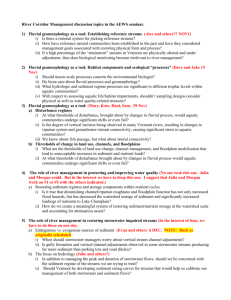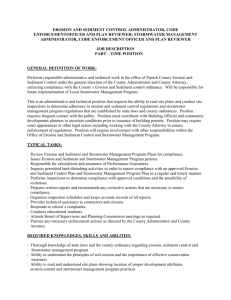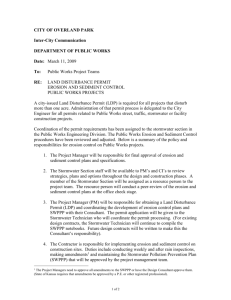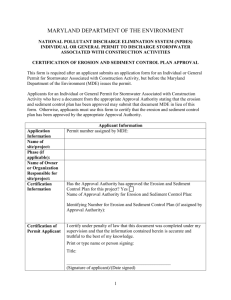sediment hazards
advertisement
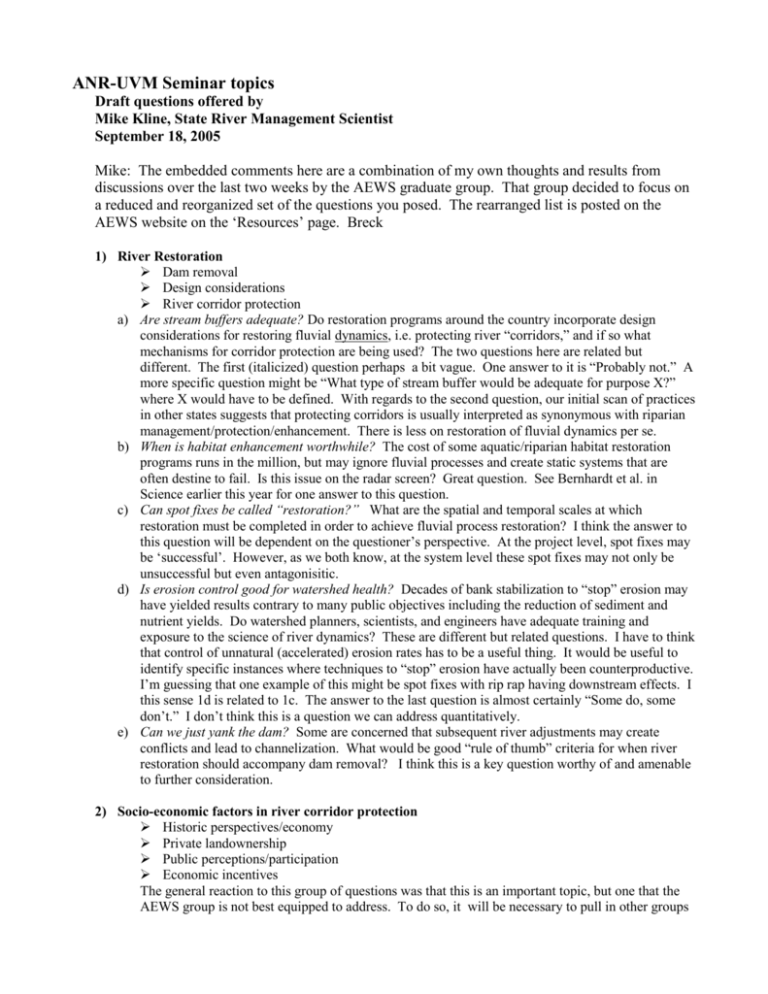
ANR-UVM Seminar topics Draft questions offered by Mike Kline, State River Management Scientist September 18, 2005 Mike: The embedded comments here are a combination of my own thoughts and results from discussions over the last two weeks by the AEWS graduate group. That group decided to focus on a reduced and reorganized set of the questions you posed. The rearranged list is posted on the AEWS website on the ‘Resources’ page. Breck 1) River Restoration Dam removal Design considerations River corridor protection a) Are stream buffers adequate? Do restoration programs around the country incorporate design considerations for restoring fluvial dynamics, i.e. protecting river “corridors,” and if so what mechanisms for corridor protection are being used? The two questions here are related but different. The first (italicized) question perhaps a bit vague. One answer to it is “Probably not.” A more specific question might be “What type of stream buffer would be adequate for purpose X?” where X would have to be defined. With regards to the second question, our initial scan of practices in other states suggests that protecting corridors is usually interpreted as synonymous with riparian management/protection/enhancement. There is less on restoration of fluvial dynamics per se. b) When is habitat enhancement worthwhile? The cost of some aquatic/riparian habitat restoration programs runs in the million, but may ignore fluvial processes and create static systems that are often destine to fail. Is this issue on the radar screen? Great question. See Bernhardt et al. in Science earlier this year for one answer to this question. c) Can spot fixes be called “restoration?” What are the spatial and temporal scales at which restoration must be completed in order to achieve fluvial process restoration? I think the answer to this question will be dependent on the questioner’s perspective. At the project level, spot fixes may be ‘successful’. However, as we both know, at the system level these spot fixes may not only be unsuccessful but even antagonisitic. d) Is erosion control good for watershed health? Decades of bank stabilization to “stop” erosion may have yielded results contrary to many public objectives including the reduction of sediment and nutrient yields. Do watershed planners, scientists, and engineers have adequate training and exposure to the science of river dynamics? These are different but related questions. I have to think that control of unnatural (accelerated) erosion rates has to be a useful thing. It would be useful to identify specific instances where techniques to “stop” erosion have actually been counterproductive. I’m guessing that one example of this might be spot fixes with rip rap having downstream effects. I this sense 1d is related to 1c. The answer to the last question is almost certainly “Some do, some don’t.” I don’t think this is a question we can address quantitatively. e) Can we just yank the dam? Some are concerned that subsequent river adjustments may create conflicts and lead to channelization. What would be good “rule of thumb” criteria for when river restoration should accompany dam removal? I think this is a key question worthy of and amenable to further consideration. 2) Socio-economic factors in river corridor protection Historic perspectives/economy Private landownership Public perceptions/participation Economic incentives The general reaction to this group of questions was that this is an important topic, but one that the AEWS group is not best equipped to address. To do so, it will be necessary to pull in other groups a) b) c) d) in the Rubenstein School (e.g., Environment, Society and Public Affairs), the Gund Institute, and other units at UVM (e.g., Community Development and Applied Ecoomics). Julie will begin to reach out to these groups to assess their interest in working in these questions. How do perceptions become ingrained? How do the necessities of our colonial predecessors form the basis for resolving conflicts today? What is the history and sequence of land use and river use in Vermont that has brought our rivers to their current physical state? How do you change public values? What do we say or demonstrate to landowners and municipalities that will generate interest in river corridor conservation. What set of incentives will interest landowners in land use conversion? Is it simply a matter of education? Should stream and riparian alterations be more heavily regulated? How does public need and perception change around conservation / environmental issues? When has the regulatory approach been effective and is there a need to redefine the values associated with “waters of the state” or “waters of the US” and achieve further river management goals by ratcheting up the rules and regulations? What is the bottom line and who is responsible? Is subsidizing river corridor land use through disaster relief or other government programs (e.g. USDA farm bill) a cost effective use of public money? Is society assuming too much of the financial risk associated with the landowners land use decisions with the river corridor? What are the economic arguments for river corridor protection? Would a cost/benefit analysis show that short term pain for long term gain is in the best interest of the landowner? of society? 3) Fluvial geomorphology as a tool for assessing the biological health and potential of Vermont rivers Establishing reference streams Habitat components and ecological “processes” Disturbance regimes In general, these were viewed as key questions that the AEWS could address. Specific comments are noted below. a) Do caddisflies care about fluvial processes and geomorphology? What hydrologic and sediment regime processes are significant to different trophic levels within aquatic communities? Should macro-scale processes concern the environmental biologist? The last question in this group is qualitative and judgmental. I think that most of use would agree that macro-scale processes are of interest in any integrated view of complex systems, as are meso- and micro-scale processes. b) Is there a rational system for picking reference? How have reference natural communities been established in the past and have they [river managers?] considered management goals associated with restoring physical form and process? If a high percentage of the “attainment” streams in Vermont are physically altered and under adjustment, then does biological monitoring become irrelevant to river management? With respect to assessing aquatic life/habitat impairments, shouldn’t sampling designs consider physical as well as water quality-related stressors? This is a key set of questions. The answer to the second to the last question should be “no” in my opinion. Rather, this raises questions about ‘thresholds’ at which geomorphic changes induce community structural changes. It also raises questions about whether the sampling design for bio-indicators is configured in such a way as to optimize for detection of geomorphic change. Similarly, the answer to question #3 should clearly be “yes”. But perhaps a better way to state this would be to ask what additional information/value could be added if physical as well as water quality stressors were considered in these sampling designs. c) Is there an argument for a process-based habitat assessment program? Are there physical parameters that will help assess both habitat components (quality pools, etc.) as well as ecological processes (sediment sorting, etc.)? At what thresholds of disturbance, brought about by changes in fluvial process, would aquatic communities undergo significant shifts or even fail? Key question, as noted above. d) We know about fish passage, but what about lateral connectivity? Is the degree of vertical incision being observed in many Vermont rivers, resulting in changes to riparian system and groundwaterstream connectivity, causing significant stress to aquatic communities? Key question. 4) The role of river management in protecting and improving water quality Restoring sediment regimes and storage components within nutrient cycles Thresholds of change in land use, channels, and floodplains Sorting out roles and responsibilities a) When and where does one work against the grain of “drainage?” First, is it true that diminishing channel/riparian roughness and floodplain function has not only increased flood hazards, but has decreased the watershed storage of sediment and significantly increased loadings of nutrients to Lake Champlain? and Second, how do we create a meaningful system of restoring sediment/nutrient storage at the watershed scale and accounting for attenuation assets? It may not be possible to answer the first question with current data (or lack thereof). However, both questions should be amendable literature searches that could provide valuable insight. b) How do we put the changes we have wrought into perspective? How do current day channel and floodplain modifications (and subsequent sedimentation-eutrophication rates) compare with the loadings that occurred in conjunction with large floods, valley rejuvenation, and other episodic events after the glaciers receded? What are the thresholds of land use change, channel management, and floodplain modification that lead to unacceptable increases in sediment and nutrient loads? Key questions c) Will the Vermont experiment catch on? The Vermont ANR is building, within its Water Quality Division, a program to integrate stormwater, flood hazard, aquatic habitat, transportation, land use, and water quality planning through a fluvial geomorphic-based river management program. Can this type of program evolve in other states or within/between federal programs? Are the programs developed to deal with problems identified 30 years ago adequately defined and connected to deal with the watershed issues we face now? Can the Vermont experiment grow and succeed without concurrent changes in federal programs? For the most part these are ‘crystal ball gazing’ questions that are not really amenable to quantitative consideration. The last question is one about which some speculation might be warranted. One directly relevant question that deserves consideration is to consider whether the ‘Vermont Experiment’ is sufficiently well integrated to maximize the likelihood of success. In other words, are the River Management, Stormwater, and Planning programs (others?) sufficiently well integrated to ensure success of the overall approach? If not, what needs to change? 5) Pre-disaster mitigation of erosion hazards in mountainous states FEMA and the National Flood Insurance Program Defining fluvial erosion hazard zones Resolving and avoiding conflicts to achieve multi-objective river corridor management a) Is erosion bad or is erosion good? The professional and lay person read has been that to stop erosion is to end flood loss, improve water quality, and save the fish. Our zeal to stop bank erosion, in the name environmental conservation and remediation, has supported land use decisions and investments that create an unending cycle of conflict and intervention and contribute to systemic fluvial adjustments, ensuring that the erosion will only get worse. How do we retreat from the notion that erosion is bad and that the real threat is creating conflicts with natural river processes we can’t control? This is going to be a very hard question to address quantitatively. The ‘answer’ is almost certainly dependent on the answerer. From a scientific point of view, erosion is neither good nor bad; it just is. In particular contexts (property loss) it is bad. In others (restoration of equilibrium form) it is good (or at least useful). b) Has FEMA’s NFIP program increased erosion hazards in Vermont? What is the history behind FEMA’s focus on inundation hazards when erosion-related flood losses have been predominant in mountainous states. Has the technical methodology for defining floodways and floodplains on the National Flood Insurance Maps led to a false sense of security and ill-advised developments next to severely incised rivers in Vermont? This could be an interesting project for a group or subgroup to work on; i.e., collecting relevant data to test this idea quantitatively. c) Where does policy meet science in defining fluvial erosion hazard zones? What river science and societal considerations should be made for minimizing risks associated with erosion—a process that potential exists everywhere? Have other states or countries attempted to address erosion hazards, and if so how? I think that New Zealand (at least) has given considerable attention to this point. Erosion (as well as tectonic) issues are of considerable importance in river management in New Zealand. d) Does public safety, hazard avoidance, and infrastructure protection create a foot in the door? Do conservationists and restoration ecologists need to concern themselves with emergency management and flood mitigation? Will being a known and trusted partner make a difference when recovery efforts create restoration opportunities, or before the disaster, when planning to avoid future encroachments may protect sensitive streams and natural communities? The answer to question #1 should be use (in my estimation). I wonder if this question is really better related to the topics considered in Section 4? 6) The role of river management in restoring stormwater impaired streams Endogenous vs. exogenous sources of sediment The focus on hydrology Geomorphic assessments and stormwater remediation a) When should stormwater managers worry about vertical stream channels adjustments? Is gully formation and vertical channel adjustments observed in some stormwater streams producing far more sediment than parking lots and road ditches—is there a public understanding of this issue? Should the pre-glacial and post-glacial marine/lake deposits in places like Chittenden County, and the fluvial processes that take place within them, be factored more strongly in assessing and managing stormwater impacts? It might be easier to approach these two questions by asking ‘how’ these processes/characteristics affect stormwater impacts. b) Should we be concerned with both watershed hydrology and sediment flow? In addition to managing the peak and duration of stormwater flows, should we be concerned with the sediment regime of the streams we are trying to treat? Will our attempt at minimizing sediment-related stressors go too far and eventually create sediment deficits and disequilibrium in some stormwater impacted streams? Should Vermont be developing sediment rating curves for streams that would help us calibrate our management of both stormwater and sediment flows? My opinion is ‘yes’ to the first and last questions and maybe to the second. To make these question more accessible, perhaps it would be better to ask ‘how’ you would put together and sediment rating curve that would address these questions. Who has done it before? What did they learn? The second question could be recast to ask how you’d know whether you’d gone too far in sediment control. Re-stated this way this might fall into the group of questions that address ‘thresholds’. c) What fluvial geomorphic data should be available to the stormwater manager? Which channel and floodplain geometry and fluvial process data should be included in any ongoing monitoring program developed fro stormwater impaired streams? How should ongoing channel adjustments and the geomorphic sensitivity of individual stream reaches be factored into a remediation program for a stormwater impacted watershed? Key qeustions

